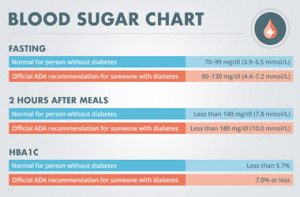While controlling your blood sugar levels may seem like a daunting task. It is a necessary practice that everyone, no matter their age, should being to take into consideration. As health and wellness are starting to become one of the hot topics in the last decade, many sciences and health professionals have compiled information on the best ways to control your blood sugar levels.
If you were wondering if your blood sugar level is exactly what it sounds like, it’s the measurement of how much glucose, or sugar, is present in your body. Before you fret, having some glucose in your blood is healthy, seeing as how our bodies use it as fuel. However, having too little of it can lead you to the hospital, and having too much can have the same effect and lead you to develop lifelong medical issues, such as diabetes.
However, gaining control of your glucose can be easily achieved if you begin making little tweaks to your lifestyle, such as exercising more and having a balanced diet.
1. Change up your meals and try out Mediterranean food
Why many may frown their faces at trying out new food, studies involving over 140,000 people, have consistently shown that the development of medical issues, such as diabetes, happen to be 20% lower for those who follow a Mediterranean diet. Many Mediterranean diets consist of plant-based meals, which includes: fruits and veggies, nuts, beans, whole grains, and cooling with olive oil. Though, meat eaters shouldn’t worry since chicken and fish are eaten regularly, just not red meat, sweets, or butter. The phytonutrients and additional fibers found in these foods can easily help people maintain healthy blood sugar levels throughout their lifetime, and olive oil is known to reduce inflammation – and even clear up skin as well.
2. Start considering blue

While this may seem like something you would hear as logo – going blue is about blue/lavender colored foods. The more anthocyanins you consume – which are commonly found in grapes and berries that happen to be of a blue and bright red colors – have been linked to healthier and more stable blood sugar levels according to a recent British scientific study. Just eating one portion of grapes and berries a day was shown to have a significant positive influence on your blood sugar levels, along with taking a point away from your BMI, also known as body mass index. Plus, easting more natural sweets such as berries and grapes are the perfect replacement to eating loads of candy filled with artificial sweeteners.
3. Stop Skipping Breakfast
We all know the routine, you either wake up to late to eat a healthy breakfast, or you just don’t feel hungry enough to eat. Studies have shown that the more you miss that delicious morning meal, the more likely you will be at risk to develop type 2 diabetes. Eating a healthy blend of complex carbs, protein, and fat at the start of your days will help stabilize your glucose levels. However, all those terms may be a bit hard to understand. But one example of a healthy morning meal that can help your glucose and start off your day correct would be a piece of whole-grain toast, with nut butter and banana slices.
4. Start sweating more and get stronger

It has been proven that women who do a combination of cardio, for at least two and a half hours, along with strength training, for at least an hour, have the lowest risk of developing diabetes by one third less. This is in comparison to their female counterparts who are frequent non-exercisers. This is caused by their muscles soaking up more glucose that is found in your bloodstream. The fitter you happen to be, the more sensitive your cells will become with insulin.
5. Stop spending so much time in front of the television
Even though sitting in front of the television and binge watching your favorite show may be enticing – a study based in England have shown that getting up and walking around for two minutes after 20 minutes of watching television can lead to the promotion of healthy blood sugar levels along with lessening the spikes your glucose will receive after eating meals.
6. Start calculating your risk
The best way to know if you’re at risk of developing diabetes at home is to take the risk test that’s featured on diabetes.org. Then take the results to your next doctors appoint and discuss your options and what your doctor recommends that you do. The higher the score, the more frequent you should check your blood sugar levels.
7. Revise your medical shelf
An array of over the counter drugs to help with everyday issues, such as asthma, control cholesterol, and even some medicines used to lower blood pressure can actually raise your blood pressure to even higher levels. The best step to do is to ask your doctor if you should continue taking these medicines and ask for recommendations for new ones.
